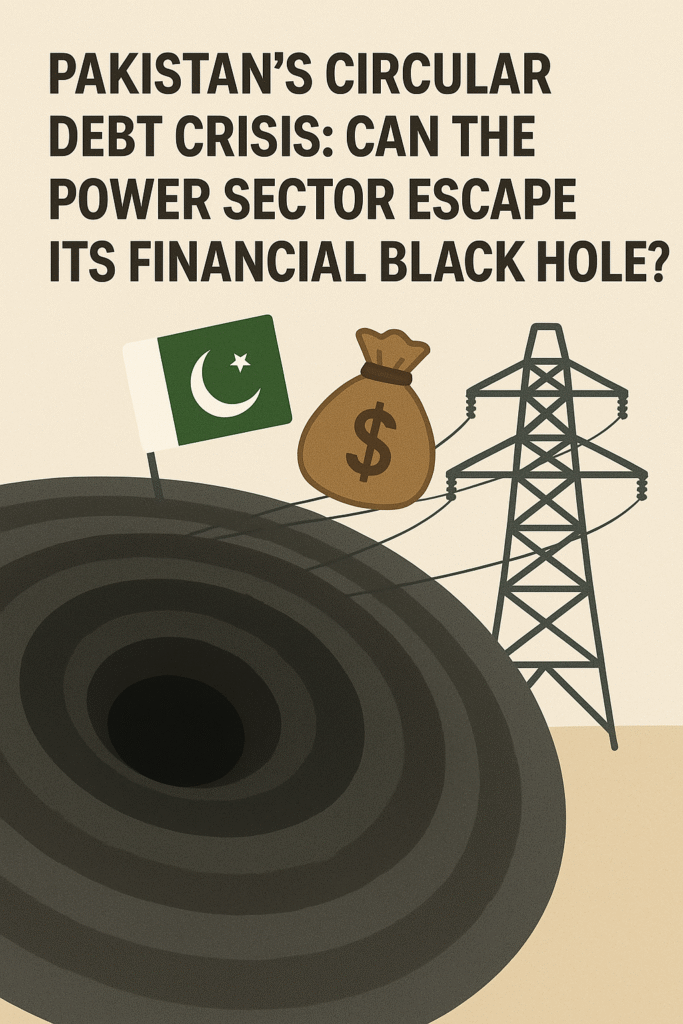
Circular debt is a persistent and escalating issue in Pakistan’s energy sector, significantly impacting the nation’s economic stability and development. As of June 2023, Pakistan’s circular debt in the electricity sector stood at approximately $8.3 billion, with an additional $6.3 billion in the gas sector, creating substantial barriers to future investment.
Understanding Circular Debt
Circular debt in Pakistan refers to the accumulation of unpaid dues within the energy supply chain. It typically begins when power distribution companies (DISCOs) fail to collect sufficient revenue from consumers, often due to inefficiencies, theft, and inadequate billing systems. This shortfall prevents DISCOs from paying power generation companies, which in turn cannot compensate fuel suppliers, creating a cascading effect of debt across the sector.
Historical Context and Growth
The issue of circular debt emerged prominently in FY2006, starting at PKR 111 billion. By June 30, 2023, this figure had escalated to PKR 2.3 trillion, indicating a severe and ongoing financial crisis within the energy sector.
Contributing Factors
Several factors contribute to the burgeoning circular debt:
Tariff Subsidies and Government Policies: The government’s provision of subsidies to keep electricity tariffs affordable often leads to delays or shortfalls in subsidy payments, exacerbating the debt situation.
Transmission and Distribution Losses: Technical inefficiencies and electricity theft result in significant losses. For instance, during FY2019–FY2020, transmission and distribution losses against the NEPRA notified average of 15.7% contributed PRs 42 billion to the circular debt flow.
Delayed Tariff Adjustments: Delays in implementing quarterly and fuel-related tariff adjustments contributed PRs 270 billion to the circular debt flow during FY2019–FY2020.
Unfunded Subsidies: Unfunded government tariff differential subsidies contributed PRs 135 billion to the circular debt flow during FY2019–FY2020.
Economic Implications
The mounting circular debt has far-reaching economic consequences:
Investment Deterrence: The debt discourages both domestic and foreign investment in the energy sector due to concerns over financial viability and payment delays.
Operational Inefficiencies: Liquidity constraints hinder the maintenance and expansion of energy infrastructure, leading to frequent power outages and unreliable supply.
Fiscal Strain: The government often resorts to borrowing to manage the debt, exacerbating the national fiscal deficit and diverting resources from essential public services.
Mitigation Efforts
To address the circular debt crisis, the Pakistani government has implemented several measures:
Circular Debt Reduction Plan (CDRP): Adopted in November 2019, the CDRP aims to reduce the annual flow of new circular debt to PRs 50–75 billion by FY2023 and eliminate all new arrears by the end of FY2023.
Energy Sector Reforms: Efforts include improving governance of DISCOs, enhancing bill collection efficiency, and reducing transmission and distribution losses.
Tariff Rationalization: Adjusting electricity tariffs to reflect actual generation and distribution costs, while ensuring targeted subsidies for vulnerable populations.
Challenges Ahead
Despite these initiatives, significant challenges persist:
Political Resistance: Reforms such as tariff increases often face opposition due to their potential impact on consumers and political repercussions.
Structural Inefficiencies: Deep-rooted inefficiencies within energy institutions and infrastructure require long-term strategies and investments to resolve.
Financial Constraints: Limited fiscal space hampers the government’s ability to invest in necessary upgrades and reforms.
The circular debt crisis in Pakistan’s energy sector is a complex and multifaceted challenge that demands comprehensive and sustained policy interventions. Addressing this issue is crucial for ensuring the country’s economic stability, attracting investment, and providing reliable energy to support development and growth.
This Article was published on Publicfinance.pk.
